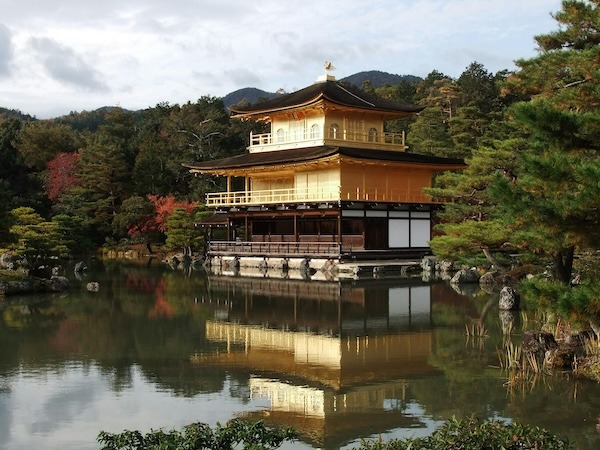Day 1: Historic Temples and Gion
Morning: Start your Kyoto adventure in Higashiyama, one of the city’s most iconic districts. Begin your day at Kiyomizu-dera, a stunning temple with a wooden stage that offers breathtaking views of the city. The temple’s main hall is supported by hundreds of wooden pillars, creating a grand architectural masterpiece. If you’re feeling adventurous, drink from the Otowa Waterfall, which is believed to bring good luck in love, studies, or longevity.
After visiting Kiyomizu-dera, take a leisurely walk down Sanneizaka and Ninenzaka, two charming streets lined with traditional wooden shops, teahouses, and souvenir stores. Be sure to stop by a local confectionery shop to try yatsuhashi, a sweet Kyoto specialty made from cinnamon and rice flour.Before noon, make your way to Yasaka Shrine, an important Shinto shrine known for its vibrant red torii gate and lantern-lit pathways. This is a great spot to take in the spiritual ambiance before heading into Gion.
Afternoon: Cross over to the famous Gion District, Kyoto’s historic geisha quarter. Stroll along Hanamikoji Street, where you may catch a glimpse of a maiko (apprentice geisha) hurrying between appointments. Stop by Gion Tatsumi Bridge, one of Kyoto’s most picturesque spots, and then visit Kennin-ji, Kyoto’s oldest Zen temple, which features stunning rock gardens and a famous ceiling painting of twin dragons.
For lunch, enjoy a Kyoto-style kaiseki meal at a traditional ryotei (Japanese restaurant), experiencing a meticulously prepared multi-course meal featuring seasonal ingredients.
Evening: As the sun sets, visit Kodai-ji Temple, famous for its beautifully maintained Zen gardens, serene bamboo grove, and stunning teahouses. The temple is especially beautiful in the evening when its gardens are illuminated, creating a magical atmosphere.
Afterward, head to Shirakawa Street, a picturesque canal-side lane where you can admire Kyoto’s traditional architecture illuminated by lanterns. Then, make your way to Pontocho Alley, a narrow atmospheric street filled with cozy restaurants and traditional izakayas. Enjoy Kyoto’s famous yudofu (hot tofu) or indulge in a multi-course wagyu meal while soaking in the old-world ambiance.

Save Tip: Skip the touristy snack stalls near Kiyomizu-dera and grab an affordable yet delicious matcha soft serve from a local shop along Ninenzaka.

Splurge Tip: Book an exclusive dinner at a Gion teahouse, where you’ll experience an intimate geisha performance and traditional Kyoto hospitality.
Day 2: Arashiyama and Northern Kyoto
Morning: Start your day early in Arashiyama to beat the crowds at the Bamboo Grove, a mesmerizing forest of towering green stalks. Feel the tranquility as the sunlight filters through the dense bamboo, creating a dreamlike atmosphere. Continue to Tenryu-ji Temple, a UNESCO World Heritage site with a breathtaking Zen garden that dates back to the 14th century.Next, cross the Togetsukyo Bridge, an iconic wooden bridge offering panoramic views of the Hozu River and surrounding mountains. If you visit in autumn, the red and gold foliage provides an unforgettable sight.
Afternoon: For a bit of adventure, hike up to Iwatayama Monkey Park, where you’ll find wild Japanese macaques roaming freely. The viewpoint at the top offers one of the best panoramic views of Kyoto.
After descending, stop by Okochi Sanso Villa, the former retreat of a famous samurai film actor. The villa features stunning gardens, a traditional teahouse, and breathtaking city views. Enjoy a cup of matcha tea with traditional sweets included in your entrance fee. Next, take a bus to Ryoan-ji, home to Kyoto’s most famous rock garden, where carefully placed stones create an enigmatic yet calming aesthetic. Finish your afternoon at Kinkaku-ji (Golden Pavilion), one of Kyoto’s most iconic landmarks, its golden facade reflecting beautifully over the tranquil pond.
Evening: Return to central Kyoto and explore Nishiki Market, also known as “Kyoto’s Kitchen.” Sample fresh seafood, yuba (tofu skin), warabimochi, and soy-based treats from local vendors. Try dashimaki tamago (Japanese omelet), a Kyoto specialty made with a flavorful dashi broth.After dinner, take a leisurely walk along Kamogawa River, where you’ll see couples and locals enjoying the cool evening breeze.

Save Tip: Save on kimono rental by booking in advance online, where discounts are often available, instead of renting on the spot at higher tourist prices.

Splurge Tip: Treat yourself to a kaiseki meal at a Michelin-starred restaurant in the Pontocho area, experiencing Kyoto’s finest dining.
Day 3: Shrines and Sake
Morning: Start your final day at Fushimi Inari Taisha, famous for its thousands of vermilion torii gates stretching up the mountain. Take your time walking through the tunnels of gates, and if you’re up for a challenge, hike to the top for an unforgettable view of Kyoto.
Afternoon: Head to the Fushimi Sake District, one of Japan’s most famous sake-producing regions. Visit the Gekkeikan Okura Sake Museum, where you can learn about the brewing process and enjoy a sake-tasting session. If time allows, visit Fushimi Yume Hyakushu, a historic sake shop where you can sample a variety of Kyoto’s finest brews.
For lunch, dine at a traditional izakaya, where you can pair local sake with dishes like grilled fish, tempura, and Kyoto-style pickles.
Evening: Spend the afternoon shopping at Shijo Street and Teramachi Shopping Arcade, where you’ll find everything from luxury brands to unique handicrafts. Visit Nijo Castle, a historic samurai-era fortress featuring ornate interiors and “nightingale floors” designed to creak when walked on to prevent intruders. End your Kyoto journey with a spectacular meal. Choose between an intimate sushi omakase experience, where the chef prepares each piece before your eyes, or indulge in a final bowl of Kyoto-style ramen at a famous local shop.

Save Tip: Instead of expensive café breakfasts, grab a fresh and filling onigiri (rice ball) or bento from a convenience store before heading to Fushimi Inari. It will definitely save you both time and money.

Splurge Tip: Spend a night at a traditional ryokan, experiencing Kyoto’s renowned hospitality with a luxurious tatami-matted room, kaiseki dinner, and relaxing onsen bath.

If you are travelling in a group, check the taxi fare to your destination. Sometimes it is cheaper to travel by cab than train, not to mention more convenient since you get to be droppped off right at the attraction you want to see.

